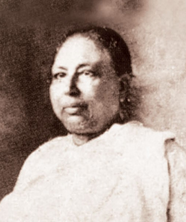- Forbes G. (1994) Medical Careers and Health Care for Indian Women: patterns of control. Women’s History Review 3: 515–530.CrossRefGoogle Scholar
- Lal M. (1994) The Politics of Gender and Medicine in Colonial India: The Countess of Dufferin’s Fund, 1885–1888. Bulletin for History of Medicine 68: 29–66.Google Scholar
- Karlekar M. (1986) Kadambini and the Bhadralok: Early Debates over Women’s Education in Bengal. Economic and Political Weekly XXI: 25–31.Google Scholar
- Deb C. (1998) Mahila Daktar: Bhin Graher Bashinda, Calcutta: Ananda Publishers.Google Scholar
- Forbes G. and Raychaudhuri T. (2000) Memoirs of Haimabati Sen: From Child Widow to Lady Doctor, New Delhi: Roli Books.Google Scholar
- Borthwick M. (1984) The Changing Role of Women in Bengal 1849–1905, Princeton: Princeton University Press.CrossRefGoogle Scholar
- Mukherjee M. (1995) Women’s Work in Bengal, 1880–1930: A Historical Analysis, Delhi: Oxford University Press.Google Scholar
- Forbes G. (2000a) Women in Modern India, Cambridge: Cambridge University Press.Google Scholar
- Balfour M.I. and Young R. (1929) The Work of Medical Women in India, London: Oxford University Press.Google Scholar
- Desivilliar R.C. (1920) Child Welfare and Infant Mortality. Journal of Association of Medical Women in India 3: 5–11. Desivilliar was the editor of the Local Self Government Gazette.Google Scholar
- Mukherjee S. (2001) Disciplining the Body? Health Care for Women and Children in Early Twentieth Century Bengal, New Delhi: Tulika.Google Scholar
- Ray B. (2001) Women, Politics and Identity in Colonial Bengal, 1900–1947, Calcutta: K.P. Bagchi and Company.Google Scholar
- Basu A. and Ray B. (1990) Women’s Struggle: A History of the All India Women’s Conference 1927–1990, Delhi: Manohar Books.Google Scholar
- Sarkar T. (1999) Words to Win: The Making of Amar Jiban: A Modern Autobiography, New Delhi: Kali for Women.Google Scholar
- Ibid., p. 3. There are a number of autobiographies and memoirs by Indian women writers for whom becoming literate and educated, and being able to write were turning points in their lives. See Forbes G. and Raychaudhuri T. (2000b) The Memoirs of Dr Haimabati Sen: From Child Widow to Lady Doctor, New Delhi: Roli Books.Google Scholar
- Bandyopadhyay A.K. and Sen A. (1998) Purnashashi Debir-r Nirbachita Rachana (Selected Writings of Purnashashi Debi), Calcutta: Deys Publishing.Google Scholar
- See also Gupta R. (1999b) Smritimanjusha: Priyabala Gupta, Calcutta.Google Scholar
- There were women from elite and well-known families who faced no apparent restrictions as far as their education was concerned and went on to become active and prominent literary, social reform, or political figures. Forbes G. (2005) Women in Colonial India: Essays on Politics, Medicine and Historiography, San Francisco: Chronicle Books.Google Scholar
- Burton A. (1996) Contesting the Zenana: The Mission to Make ‘Lady Doctors for India, 1874–1885’. Journal of British Studies 35: 368–397.CrossRefGoogle Scholar
- Karlekar (1986) Economic and Political Weekly XXI: 25–31.Google Scholar
- I use the term ‘new knowledge’ from Sidonie Smith and Julia Watson’s essay where they discuss how ‘agency’ becomes central to discussions of women’s autobiographies. See Smith S. (1998) Women, Autobiography, Theory: A Reader, Madison: University of Wiscons in Press.Google Scholar
- Gupta R. (1999a) Alor Abhimukhe: The Life and Times of Priyabala Gupta, Calcutta: Dey’s Publishers, p. 133.Google Scholar
- Debi P. (1941) Smritimanjusha, Calcutta: Dey’s Publishers.Google Scholar
- Bandyopadhyay A. (1998) The Way I Have Seen Purnashashi, Calcutta: Dey’s Publishers, p. 27.Google Scholar
- Gigliotti S. (2002) Technology, Trauma and Representation: Holocaust Testimony and Videotape, Manchester: Manchester University Press.Google Scholar
- Dyson L. (2002) Collecting Practices and Autobiography: The Role of Objects in the Mnemonic Landscape of Nation, Manchester: Manchester University Press, p. 129.Google Scholar
- Turkle S. (2007b) What Makes an Object Evocative? Cambridge, MA: MIT Press, p. 307.Google Scholar
- Petersen A. (1997a) The New Public Health: Discourses, Knowledge, Strategies, Thousand Oaks, CA: Sage Publications.Google Scholar
- Bagchi J. (1999) Preface, ‘The Light of Your Life’. In: Gupta R. (ed.) Smritimanjusha. Calcutta: Dey’s Publishing.Google Scholar
- Debi P. (1963) Mone Pare, Calcutta, p. 223.Google Scholar

Sen, Haimabati, approximately 1866-1933 Women physicians India Biography. Haimabati Sen was 26, somewhat older than the average age of 21 years. Many thought the program would appeal only to Brahmo and native Christian women but this was not the case. In the first two years, there were more Hindu women, mostly Brahmins and Kayasthas, than. The autobiography, The Memoirs of Haimabati Sen, is valuable for the light it throws on women's lives in the late 19th and early 20th centuries. This memoir of an unusual woman maps the nuances, the twists and turns of the immeasurably long journey of a woman in 19th century rural East Bengal from becoming a child-widow at the age of 10 to.
It's a true story of a lady from 18th century who born in rural Bengal in 1866. She married with a 45 years old man, when she was just 9 years old...... that's not shocking because at that time it was common in Bengali community. The MAN didn't satisfy with a CHILD, so he brought women from brothel in his bedroom. God saved Haimabati, her husband died when she was 10 years old...... after one year of their marriage.Haimabati fight against the society and married again when she in 25. I write it in only one sentence but believe me the struggle was not so easy at that time. This time she was lucky, got a BETTER !!! husband.

Haimabati Sen Wikipedia

She learned something about medicines and started a journey as a lady doctor in Chuchura in West Bengal.

This is a true story...... writing by Professor Geraldine Forbes, Distinguished Teaching Professor of History and Dr. Tapan Roychoudhury an Indian Historian specializing in British history, Indian History and History of Bengal. Published by Roli Books, U.K.

Dr Haimabati Sen
Now you can buy the book online shopping sites like Amazon, Flipkart etc.
